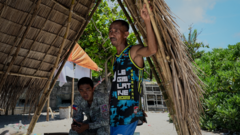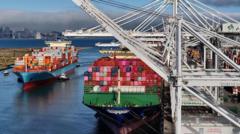Amidst growing Chinese maritime dominance, Pagasa Island, home to a small community of Filipinos, becomes a symbol of resistance, highlighting the challenges faced by its residents under constant threat from Chinese naval operations.
**Island of Hope: Pagasa Defies Chinese Domination in the South China Sea**

**Island of Hope: Pagasa Defies Chinese Domination in the South China Sea**
Residents of Pagasa Island stand firm against Chinese incursions, showcasing resilience amidst geopolitical tensions.
In the remote South China Sea, Pagasa Island, also known as Thitu, serves as a bastion of Filipino identity against a backdrop of Chinese aggression. Despite covering a mere 37 hectares, this tiny island is home to around 300 resilient inhabitants who rely on the surrounding turquoise waters for fishing and a modest agriculture. Their peaceful livelihood is constantly threatened by a flotilla of Chinese coastguard and militia vessels claiming nearby waters.
For the past decade, China has maneuvered to assert control over the South China Sea by occupying submerged reefs, constructing military airbases, and deploying an extensive fleet to dominate the region. Other Southeast Asian nations, besieged by China's overwhelming military strength, have largely refrained from challenging its assertions, with only the Philippines and Vietnam taking a stand. Pagasa holds a unique position in this geopolitical strife, boasting not only solid land but also a civilian populace that enhances the Philippines' legal claim to the territory under international law.
"Pagasa is deeply important for us," asserts Jonathan Malaya of the Philippines National Security Council. With its runway and resident community, Pagasa symbolizes a vital Philippine presence in contested waters. Accessing the island poses challenges; it requires either a perilous two-to-three-day boat journey or a one-hour flight, both susceptible to fierce storms. Recent infrastructure improvements, including a newly surfaced runway for larger aircraft, have bolstered logistics.
Survival on the island hinges on government support, food supplies, and fishing. Fishermen like Larry Hugo face increasing pressures from Chinese vessels that intimidate local fishermen, forcing them into closer fishing grounds with dwindling catches. Hugo, a long-term Pagasa resident, has documented the marked escalation of Chinese interference, including close encounters at sea with coastguard ships.
For many, including teacher Realyn Limbo, the island represents a serene paradise offering basic needs and a nurturing environment for over 100 local children. On Pagasa, life moves at a slower pace, but it is not without its challenges, particularly concerning medical emergencies that require costly evacuations to the mainland.
Pagasa's growing infrastructure, including housing and a new school, showcases its commitment to sustaining a community. Yet, as young residents seek opportunities elsewhere, there are lingering concerns over balancing preservation of their lifestyle with the threats looming from nearby Chinese bases like Subi Reef.
The Philippine government has intensified diplomatic efforts, lodging weekly protests against Chinese incursions. With shifts in leadership affecting policies toward Beijing, the path forward remains precarious, straddling the fine line between asserting sovereignty and seeking stability in a turbulent geopolitical landscape. Pagasa stands not just as an island but as a testament to resilience and tenacity -- a microcosm of the larger fight for sovereignty in one of the world's most contested waters.


















